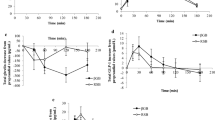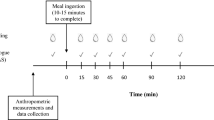Abstract
Purpose
Efforts regarding the amelioration of postprandial glycemic response to bread are mainly focused in the addition of soluble dietary fibers. The current study presents another approach which is based on the supplementation of flour with Cr-enriched yeast. Cr is known for its beneficial effects on improvement of glucose tolerance and enhancement of insulin sensitivity.
Methods
Twelve normoglycemic subjects were provided with white bread (WB, reference food) or whole wheat bread with Cr-enriched yeast (WWCrB, rich in insoluble fibers) or white wheat bread with Cr-enriched yeast (WCrB, poor in fibers) or whole wheat-rye-barley bread enriched with oat beta glucans (BGB, rich in soluble fibers) with 1-week intervals in amounts that yielded 50 g of available carbohydrates. Postprandial glucose, insulin and ghrelin responses as well as glycemic index (GI) were evaluated.
Results
Ingestion of WWCrB, WCrB and BGB elicited lower incremental area under the curve (iAUC) for 120-min glycemic response compared to WB (1033.02 ± 282.32, 701.69 ± 330.86 and 748.95 ± 185.42 vs 2070.87 ± 518.44 mg/dL min, respectively, P < 0.05 for WCrB and BGB). The GI was calculated as 62.35 ± 11.78 for WWCrB, 34.22 ± 11.93 for WCrB and 37.90 ± 5.00 for BGB (P < 0.05 vs WB, GI = 100). iAUC for 120-min insulin response to BGB was significantly lower than WB (2780.04 ± 303.26 vs 3915.53 ± 490.57 μU/mL min, P < 0.05), while ghrelin remained suppressed for almost 120 min after the consumption of WWCrB and BGB.
Conclusions
Supplementation of flour with Cr-enriched yeast induces milder postprandial glycemic response to bread without the necessity of high fiber amounts, providing with another strategy for the management of glycemic control.



Similar content being viewed by others
References
Fan J, Song Y, Wang Y, Hui R, Zhang W (2012) Dietary glycemic index, glycemic load, and risk of coronary heart disease, stroke, and stroke mortality: a systematic review with meta-analysis. PLoS One 7(12):e52182
Mirrahimi A, Chiavaroli L, Srichaikul K, Augustin LS, Sievenpiper JL, Kendall CW, Jenkins DJ (2014) The role of glycemic index and glycemic load in cardiovascular disease and its risk factors: a review of the recent literature. Curr Atheroscler Rep 16(1):381
Thomas DE, Elliott EJ (2010) The use of low-glycaemic index diets in diabetes control. Br J Nutr 104(6):797–802
Ajala O, English P, Pinkney J (2013) Systematic review and meta-analysis of different dietary approaches to the management of type 2 diabetes. Am J Clin Nutr 97(3):505–516
FAO (1998) Carbohydrates in human nutrition. In: Report of a joint FAO/WHO expert consultation (FAO Food and Nutrition Paper 66). Food and Agriculture Organization, Rome
Sadler M (2011) Influence of glycaemic response on health indicators. In: John H (ed) Food, glycaemic response and health. ILSI Europe Concise Monograph Series, ILSI Europe Publications, Belgium, pp 12–21
Dyson PA, Kelly T, Deakin T, Duncan A, Frost G, Harrison Z, Khatri D, Kunka D, McArdle P, Mellor D, Oliver L, Worth J (2011) Diabetes UK nutrition working group diabetes UK evidence-based nutrition guidelines for the prevention and management of diabetes. Diabet Med 28(11):1282–1288
Evert AB, Boucher JL, Cypress M, Dunbar SA, Franz MJ, Mayer-Davis EJ, Neumiller JJ, Nwankwo R, Verdi CL, Urbanski P, Yancy WS Jr (2014) Nutrition therapy recommendations for the management of adults with diabetes. Diabetes Care 37(Suppl 1):S120–S143
Cust AE, Skilton MR, van Bakel MM, Halkjaer J, Olsen A, Agnoli C, Psaltopoulou T, Buurma E, Sonestedt E, Chirlaque MD, Rinaldi S, Tjønneland A, Jensen MK, Clavel-Chapelon F, Boutron-Ruault MC, Kaaks R, Nöthlings U, Chloptsios Y, Zylis D, Mattiello A, Caini S, Ocké MC, van der Schouw YT, Skeie G, Parr CL, Molina-Montes E, Manjer J, Johansson I, McTaggart A, Key TJ, Bingham S, Riboli E, Slimani N (2009) Total dietary carbohydrate, sugar, starch and fibre intakes in the European Prospective Investigation into Cancer and Nutrition. Eur J Clin Nutr 63(Suppl 4):S37–S60
Juntunen KS, Niskanen LK, Liukkonen KH, Poutanen KS, Holst JJ, Mykkänen HM (2002) Postprandial glucose, insulin, and incretin responses to grain products in healthy subjects. Am J Clin Nutr 75(2):254–262
Fardet A, Leenhardt F, Lioger D, Scalbert A, Rémésy C (2006) Parameters controlling the glycaemic response to breads. Nutr Res Rev 19(1):18–25
Wolever TM, Tosh SM, Gibbs AL, Brand-Miller J, Duncan AM, Hart V, Lamarche B, Thomson BA, Duss R, Wood PJ (2010) Physicochemical properties of oat β-glucan influence its ability to reduce serum LDL cholesterol in humans: a randomized clinical trial. Am J Clin Nutr 92(4):723–732
Scazzina F, Siebenhandl-Ehn S, Pellegrini N (2013) The effect of dietary fibre on reducing the glycaemic index of bread. Br J Nutr 109(7):1163–1174
Wang Q, Ellis PR (2014) Oat β-glucan: physico-chemical characteristics in relation to its blood-glucose and cholesterol-lowering properties. Br J Nutr 112(Suppl 2):S4–S13
Andersson A, Tengblad S, Karlström B, Kamal-Eldin A, Landberg R, Basu S, Aman P, Vessby B (2007) Whole-grain foods do not affect insulin sensitivity or markers of lipid peroxidation and inflammation in healthy, moderately overweight subjects. J Nutr 137(6):1401–1407
Groff JL, Gropper SS (1999) Chromium. In: Laura G (ed) Advanced nutrition and human metabolism. Wadsworth/Thomson Learning, Belmont, USA, pp 446–451
Hua Y, Clark S, Ren J, Sreejayan N (2012) Molecular mechanisms of chromium in alleviating insulin resistance. J Nutr Biochem 23(4):313–319
Scwartz K, Mertz W (1957) A glucose tolerance factor and its differentiation of factor 3. Arch Biochem Biophys 72:515–518
Mertz W, Schwartz K (1959) Relation of glucose tolerance factor to impaired intravenous glucose tolerance of rats on stock diets. Am J Physiol 196:614–618
Weksler-Zangen S, Mizrahi T, Raz I, Mirsky N (2012) Glucose tolerance factor extracted from yeast: oral insulin-mimetic and insulin-potentiating agent: in vivo and in vitro studies. Br J Nutr 108(5):875–882
Frauchiger MT, Wenk C, Colombani PC (2004) Effects of acute chromium supplementation on postprandial metabolism in healthy young men. J Am Coll Nutr 23(4):351–357
Pei D, Hsieh CH, Hung YJ, Li JC, Lee CH, Kuo SW (2006) The influence of chromium chloride-containing milk to glycemic control of patients with type 2 diabetes mellitus: a randomized, double-blind, placebo-controlled trial. Metabolism 55(7):923–927
Chen YL, Lin JD, Hsia TL, Mao FC, Hsu CH, Pei D (2014) The effect of chromium on inflammatory markers, 1st and 2nd phase insulin secretion in type 2 diabetes. Eur J Nutr 53(1):127–133
Suksomboon N, Poolsup N, Yuwanakorn A (2014) Systematic review and meta-analysis of the efficacy and safety of chromium supplementation in diabetes. J Clin Pharm Ther 39(3):292–306
Brouns F, Bjorck I, Frayn KN, Gibbs AL, Lang V, Slama G, Wolever TM (2005) Glycaemic index methodology. Nutr Res Rev 18(1):145–171
Margetts B (2003) FAO/WHO launch expert report on diet, nutrition and prevention of chronic diseases. Public Health Nutr 6(4):323–325
Livesey G, Taylor R, Hulshof T, Howlett J (2008) Glycemic response and health—a systematic review and meta-analysis: the database, study characteristics, and macronutrient intakes. Am J Clin Nutr 87(1):223S–236S
Bhupathiraju SN, Tobias DK, Malik VS, Pan A, Hruby A, Manson JE, Willett WC, Hu FB (2014) Glycemic index, glycemic load, and risk of type 2 diabetes: results from 3 large US cohorts and an updated meta-analysis. Am J Clin Nutr 100(1):218–232
Ostman EM, Nilsson M, Liljeberg Elmstahl HGM, Molin G, Björck IM (2002) On the effect of lactic acid on blood glucose and insulin responses to cereal products: mechanistic studies in healthy subjects and in vitro. J Cereal Sci 36:339–346
Anderson RA, Polansky MM, Bryden NA, Patterson KY, Veillon C, Glinsmann WH (1983) Effects of chromium supplementation on urinary Cr excretion of human subjects and correlation of Cr excretion with selected clinical parameters. J Nutr 113(2):276–281
Davis CM, Vincent JB (1997) Chromium oligopeptide activates insulin receptor tyrosine kinase activity. Biochemistry 36(15):4382–4385
Cefalu WT, Wang ZQ, Zhang XH, Baldor LC, Russell JC (2002) Oral chromium picolinate improves carbohydrate and lipid metabolism and enhances skeletal muscle Glut-4 translocation in obese, hyperinsulinemic (JCR-LA corpulent) rats. J Nutr 132(6):1107–1114
Penumathsa SV, Thirunavukkarasu M, Samuel SM, Zhan L, Maulik G, Bagchi M, Bagchi D, Maulik N (2009) Niacin bound chromium treatment induces myocardial Glut-4 translocation and caveolar interaction via Akt, AMPK and eNOS phosphorylation in streptozotocin induced diabetic rats after ischemia-reperfusion injury. Biochim Biophys Acta 1792(1):39–48
Weickert MO, Spranger J, Holst JJ, Otto B, Koebnick C, Möhlig M, Pfeiffer AF (2006) Wheat-fibre-induced changes of postprandial peptide YY and ghrelin responses are not associated with acute alterations of satiety. Br J Nutr 96(5):795–798
Vitaglione P, Lumaga RB, Stanzione A, Scalfi L, Fogliano V (2009) Beta-Glucan-enriched bread reduces energy intake and modifies plasma ghrelin and peptide YY concentrations in the short term. Appetite 53(3):338–344
Flanagan DE, Evans ML, Monsod TP, Rife F, Heptulla RA, Tamborlane WV, Sherwin RS (2003) The influence of insulin on circulating ghrelin. Am J Physiol Endocrinol Metab 284(2):E313–E316
Lucidi P, Murdolo G, Di Loreto C, De Cicco A, Parlanti N, Fanelli C, Santeusanio F, Bolli GB, De Feo P (2002) Ghrelin is not necessary for adequate hormonal counterregulation of insulin-induced hypoglycemia. Diabetes 51(10):2911–2914
Saad MF, Bernaba B, Hwu CM, Jinagouda S, Fahmi S, Kogosov E, Boyadjian R (2002) Insulin regulates plasma ghrelin concentration. J Clin Endocrinol Metab 87(8):3997–4000
Onakpoya I, Posadzki P, Ernst E (2013) Chromium supplementation in overweight and obesity: a systematic review and meta-analysis of randomized clinical trials. Obes Rev 14(6):496–507
Tian H, Guo X, Wang X, He Z, Sun R, Ge S, Zhang Z (2013) Chromium picolinate supplementation for overweight or obese adults. Cochrane Database Syst Rev 11:CD010063
EFSA Panel on Food Additives and Nutrient Sources added to Food (2010) Scientific opinion on the safety of trivalent chromium as a nutrient added for nutritional purposes to foodstuffs for particular nutritional uses and foods intended for general population (including food supplements). EFSA J 8(12):1882
Acknowledgments
Authors are grateful to the volunteers who participated in the study and all the persons involved in the conduct of the study. This work was supported by a research grant from the Greek General Secretariat for Research and Technology (PAVET 2013) and ELBISCO S.A.
Author information
Authors and Affiliations
Corresponding author
Ethics declarations
Conflict of interest
On behalf of all the authors, corresponding author states that there is no conflict of interest.
Ethical standard
All human studies have been approved by the appropriate ethics committee and have therefore been performed in accordance with the ethical standards laid down in the 1964 Declaration of Helsinki and its later amendments. All persons gave their informed consent prior to their inclusion in the study.
Rights and permissions
About this article
Cite this article
Yanni, A.E., Stamataki, N., Stoupaki, M. et al. Cr-enriched yeast: beyond fibers for the management of postprandial glycemic response to bread. Eur J Nutr 56, 1445–1453 (2017). https://doi.org/10.1007/s00394-016-1190-4
Received:
Accepted:
Published:
Issue Date:
DOI: https://doi.org/10.1007/s00394-016-1190-4




